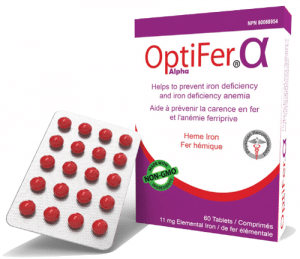Product Review
New Heme Iron Supplement: OptiFer® Alpha
 When patients develop gastrointestinal diseases and disorders, nutritional deficiencies are a common manifestation. Inflammation can reduce the body’s ability to absorb certain nutrients in untreated Crohn’s disease and celiac disease. Gastrointestinal bleeding can lead to iron loss in Crohn’s disease, ulcerative colitis, and ulcer disease. Some patients avoid certain foods or reduce food intake due to symptoms, such as nausea, vomiting, and diarrhea, which are common in many different digestive diseases and disorders, including gastroparesis, inflammatory bowel disease, irritable bowel syndrome, and functional dyspepsia. In these situations, patients can develop anemia due to iron deficiency.
When patients develop gastrointestinal diseases and disorders, nutritional deficiencies are a common manifestation. Inflammation can reduce the body’s ability to absorb certain nutrients in untreated Crohn’s disease and celiac disease. Gastrointestinal bleeding can lead to iron loss in Crohn’s disease, ulcerative colitis, and ulcer disease. Some patients avoid certain foods or reduce food intake due to symptoms, such as nausea, vomiting, and diarrhea, which are common in many different digestive diseases and disorders, including gastroparesis, inflammatory bowel disease, irritable bowel syndrome, and functional dyspepsia. In these situations, patients can develop anemia due to iron deficiency.
Luckily, there are many supplements available to help increase iron blood levels. There are two main types of dietary iron: heme and non-heme. Heme iron is only found in meat (including poultry and fish); in this form, the iron is bound to specific proteins that make it easier for the body to absorb and use the iron. Non-heme iron is present in eggs and plant foods, and is not bound to these proteins.
Most iron supplements contain non-heme iron, because it is typically easier to produce and lower in cost. However, due to the high dosing and low absorption, non-heme iron supplements frequently cause gastrointestinal symptoms, including abdominal pain, constipation, diarrhea, nausea, and vomiting. These side effects, combined with potential pre-existing symptoms, make it difficult for those with gastrointestinal diseases and disorders to tolerate non-heme supplements. Non-heme iron can also be more difficult for the body to absorb (low bioavailability). It is often necessary to combine non-heme iron with vitamin C to increase absorption, and to avoid certain types of foods and drinks that can block absorption, such as chocolate and coffee. However, there are newer supplements available that use the more effective heme iron.
OptiFer® Alpha is a heme iron supplement that is easily absorbed (high bioavailability) through the heme-receptor located in the intestine. Due to the low dosing and high absorption rate, heme iron produces fewer gastrointestinal side effects. Further, the foods or drinks you consume do not affect heme iron’s absorption rate. OptiFer® Alpha is also safe to take during pregnancy when iron supplementation is often necessary due to an increased risk of iron deficiency anemia.
Individuals who are deficient in iron and have difficulty tolerating typical non-heme iron supplements due to side effects should consider talking to a physician about trying OptiFer® Alpha as an option. Go to www.optiferalpha.com to learn more about this product.
Remember, it is not what you consume, but what your body can absorb.
Why Do We Need Iron?
Iron is an essential component of the protein in red blood cells that carries oxygen from the lungs to the cells throughout the body (hemoglobin). When someone does not absorb enough iron (through lack of dietary intake or through inflammation in the intestinal tract) or when someone loses too much iron (through bleeding), the body is unable to produce enough hemoglobin, causing anemia.
Symptoms of iron deficiency anemia can include fatigue, dizziness or light-headedness, headache, insomnia, pallor, shortness of breath on exertion, cravings to eat things that aren’t food (pica), cold hands and feet, tongue swelling, brittle nails or hair, and irregular heartbeat.
Foods High in Iron
Heme Iron: liver, kidney, beef, lamb, venison, poultry, seafood
Non-Heme Iron: lentils, beans, nuts and seeds, peas, molasses, fortified grains, dried fruit

